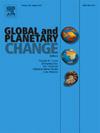Erosion modulates the effect of chemical weathering on atmospheric pCO2, Qinghai-Tibet Plateau
IF 4
1区 地球科学
Q1 GEOGRAPHY, PHYSICAL
引用次数: 0
Abstract
Chemical weathering plays an important role in modulating Earth's climate. However, chemical weathering is usually influenced by multiple factors simultaneously (e.g., climate, topography and lithology), and it is difficult to understand how these variables modulate the effect of chemical weathering on atmospheric pCO2. In this study, we collected and analyzed water chemistry and multiple isotopes (δ34SSO4, δ18OSO4 and δ18OH2O) in the Bailong River catchment to decipher how these variables influence chemical weathering and its effect on atmospheric pCO2. We used the Monte Carlo inversion model to partition the sources of major cations and , and the results reveal that carbonate weathering is the dominant source contributing cations in river. Sulfide oxidation is the most important source for and a supply-limited process that is highly dependent on slope. We thus think slope is main factor modulating the effect of chemical weathering on atmospheric pCO2. Steep slope increases sulfide oxidation rate by elevating erosion, resulting in chemical weathering acting as a CO2 source. In contrast, gentle slope could facilitate a thick regolith that contributes long-term silicate weathering and limits sulfide oxidation, resulting in chemical weathering acting as a CO2 sink. And it has been found that the influence of temperature on chemical weathering becomes progressively pronounced with increasing altitude. This study investigated sulfide weathering in eroding Qinghai-Tibet Plateau, highlighting the geomorphologically controlled CO2 effects of chemical weathering.
青藏高原侵蚀调节化学风化作用对大气 pCO2 的影响
化学风化作用在调节地球气候方面发挥着重要作用。然而,化学风化作用通常同时受到多种因素(如气候、地形和岩性)的影响,因此很难了解这些变量如何调节化学风化作用对大气 pCO2 的影响。在本研究中,我们收集并分析了白龙江流域的水化学和多种同位素(δ34SSO4、δ18OSO4 和 δ18OH2O),以解读这些变量如何影响化学风化作用及其对大气 pCO2 的影响。我们利用蒙特卡罗反演模型对主要阳离子和 SO42- 的来源进行了划分,结果表明碳酸盐风化是河流中阳离子的主要来源。硫化物氧化是 SO42- 的最重要来源,也是一个与坡度高度相关的供应受限过程。因此,我们认为坡度是调节化学风化对大气 pCO2 影响的主要因素。陡坡通过提高侵蚀作用增加硫化物的氧化率,导致化学风化作用成为二氧化碳的来源。与此相反,缓坡有利于形成厚厚的沉积岩,从而促进硅酸盐的长期风化,限制硫化物的氧化,使化学风化成为二氧化碳的吸收汇。研究还发现,温度对化学风化的影响随着海拔的升高而逐渐明显。本研究对青藏高原侵蚀作用下的硫化物风化作用进行了研究,突出了化学风化作用受地貌控制的二氧化碳效应。
本文章由计算机程序翻译,如有差异,请以英文原文为准。
求助全文
约1分钟内获得全文
求助全文
来源期刊

Global and Planetary Change
地学天文-地球科学综合
CiteScore
7.40
自引率
10.30%
发文量
226
审稿时长
63 days
期刊介绍:
The objective of the journal Global and Planetary Change is to provide a multi-disciplinary overview of the processes taking place in the Earth System and involved in planetary change over time. The journal focuses on records of the past and current state of the earth system, and future scenarios , and their link to global environmental change. Regional or process-oriented studies are welcome if they discuss global implications. Topics include, but are not limited to, changes in the dynamics and composition of the atmosphere, oceans and cryosphere, as well as climate change, sea level variation, observations/modelling of Earth processes from deep to (near-)surface and their coupling, global ecology, biogeography and the resilience/thresholds in ecosystems.
Key criteria for the consideration of manuscripts are (a) the relevance for the global scientific community and/or (b) the wider implications for global scale problems, preferably combined with (c) having a significance beyond a single discipline. A clear focus on key processes associated with planetary scale change is strongly encouraged.
Manuscripts can be submitted as either research contributions or as a review article. Every effort should be made towards the presentation of research outcomes in an understandable way for a broad readership.
 求助内容:
求助内容: 应助结果提醒方式:
应助结果提醒方式:


